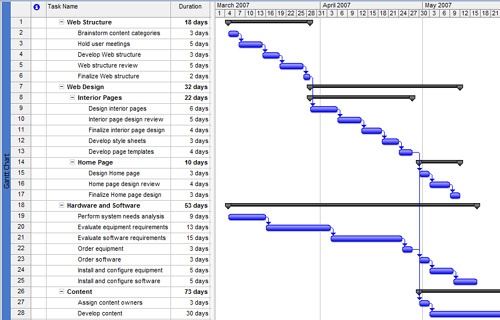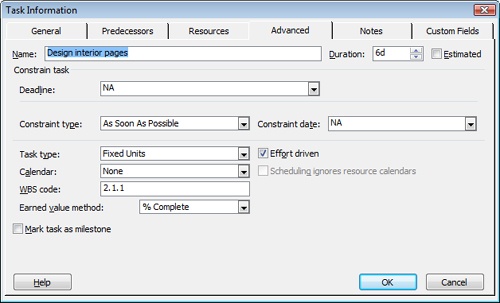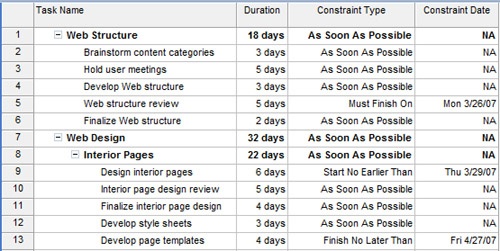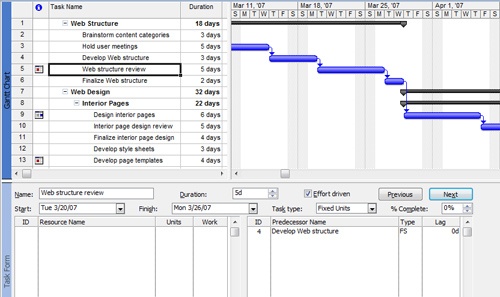With task dependencies established, your project schedule is taking shape and looking more and more realistic (see Figure 5-13).
Figure 5-13. With durations entered and tasks linked, the Gantt Chart shows more meaningful schedule information.
Microsoft Project uses the task information and controls that you enter to schedule your project from start to finish. By default, Microsoft Project schedules each task to start "As Soon As Possible."
Note
For the standard project being scheduled from the project start date, Microsoft Project applies a default constraint of "As Soon As Possible." If you’re scheduling from the project finish date, by default, Microsoft Project schedules each task to start "As Late As Possible."
However, you might have additional dates to consider. For example, maybe certain pivotal supplies will not be ready for use in the project until after April 6. Perhaps an important review meeting is taking place on June 29 that will set the stage for work toward the final milestones. Maybe one of your deliverables is a presentation at a key professional conference held on August 22.
To schedule around these important dates, you can set a constraint, which is a restriction on the start or finish date of a task. All tasks have a constraint applied—at the very least, the default As Soon As Possible constraint. The As Soon As Possible constraint indicates that the task should be scheduled according to its working times calendars, duration, task dependencies, and any resource assignments—without regard to any specific date.
The As Soon As Possible (ASAP) constraint is applied by default to all tasks in a project scheduled from the start date. In a project scheduled from the finish date, the As Late As Possible (ALAP) constraint is applied. The As Soon As Possible and As Late As Possible constraints are considered flexible constraints.
Note
Different types of constraints are applied in certain situations, depending on whether you’re working with a project scheduled from the start date or from the finish date. For example, entering a date in the Start field of a project scheduled from the start date causes a Start No Earlier Than constraint to be applied. Doing the same thing in a project scheduled from the finish date causes a Start No Later Than constraint to be applied.
When a task needs to be scheduled in relation to a specific date, there are additional constraints you can apply, each of which is associated with a date. The following is a list of all the date constraints you can use to refine your project schedule:
Start No Earlier Than (SNET). A moderately flexible constraint that specifies the earliest possible date that a task can begin. For projects scheduled from a start date, this constraint is automatically applied when you enter a start date for a task.
Finish No Earlier Than (FNET). A moderately flexible constraint that specifies the earliest possible date that this task can be completed. For projects scheduled from a start date, this constraint is automatically applied when you enter a finish date for a task.
Start No Later Than (SNLT). A moderately flexible constraint that specifies the latest possible date that this task can begin. For projects scheduled from a finish date, this constraint is automatically applied when you enter a start date for a task.
Finish No Later Than (FNLT). A moderately flexible constraint that specifies the latest possible date that this task can be completed. For projects scheduled from a finish date, this constraint is automatically applied when you enter a finish date for a task.
Must Start On (MSO). An inflexible constraint that specifies the exact date a task must begin. Other scheduling controls such as task dependencies become secondary to this requirement.
Must Finish On (MFO). An inflexible constraint that specifies the exact date on which a task must be completed. Other scheduling controls such as task dependencies become secondary to this requirement.
Remember, tasks always have a constraint applied—even if it’s just As Soon As Possible or As Late As Possible. So we never think of adding or removing constraints. When making a change, we’re typically changing a constraint from a flexible one to a more inflexible one or vice versa.
There are several methods for changing constraints, as follows:
In the Gantt Chart or similar view with a task sheet, type or select dates in the Start or Finish fields. In a project scheduled from the start date, this causes a Start No Earlier Than or Finish No Earlier Than constraint to be applied. In a project scheduled from the finish date, this causes a Start No Later Than or Finish No Later Than constraint to be applied.
In any task view, select the task whose constraint you want to change and then click Task Information on the Standard toolbar. In the Task Information dialog box, click the Advanced tab (see Figure 5-14). In the Constraint Type box, click the constraint type you want to apply to this task. If applicable, enter the date in the Constraint Date box.
On the Project Guide toolbar, click Tasks. In the Project Guide pane, click the Set Deadlines And Constrain Tasks link. Read the information under Constrain A Task and use the controls that are provided to set constraints.
In the Gantt Chart or other view with a task sheet, apply the Constraint Dates table. Click View, Table, More Tables. In the More Tables dialog box, click Constraint Dates and then click the Apply button. The table is applied to the view (see Figure 5-15). In the Constraint Type field, click the constraint type you want to apply to this task. If applicable, enter the date in the Constraint Date box.
Caution!
If a task has no predecessors, changing the constraint to an As Soon As Possible (or As Late As Possible) constraint can move the scheduling of the task back in time to the project start date. Always check the new start and finish dates on a task when you have changed constraint types to make sure the task is being scheduled the way you expect.
Three levels of flexibility are associated with task constraints: flexible, moderately flexible, and inflexible.
The flexible constraints are As Soon As Possible and As Late As Possible. These constraints work with task dependencies to schedule a task as soon or as late as the task dependency and other scheduling considerations will accommodate. These default constraints give Microsoft Project maximum flexibility in calculating start and finish dates for the tasks. For example, a task with an As Soon As Possible constraint and a finish-to-start dependency is scheduled as soon as the predecessor task finishes.
The moderately flexible constraints—Start No Earlier Than, Start No Later Than, Finish No Earlier Than, and Finish No Later Than—have a range of dates to work within. That is, the task is restricted to starting or finishing before or after the date you choose, which provides some room for flexibility, even though a date is in place. For example, a task with a Start No Later Than constraint for November 14 and a finish-to-start dependency to another task can begin any time its predecessor is finished up until November 14, but it cannot be scheduled after November 14.
The inflexible constraints—Must Start On and Must Finish On—have an absolute single date that the schedule must accommodate, which means that other scheduling considerations must fall by the wayside if necessary to meet this date. By default, constraints take precedence over task dependencies when there’s a conflict between the two. For example, a task with a Must Finish On constraint for April 30 and a finish-to-start dependency to another task is always scheduled for April 30, regardless of whether the predecessor finishes on time.
With the right constraints in place, you have the beginnings of a schedule. The Gantt Chart can provide a great deal of information about your constraints and other scheduling controls.
You can sort tasks by Start Date, Finish Date, Constraint Type, or Constraint Date. You can group tasks by Constraint Type. You can filter tasks by the Should Start By date or the Should Start/Finish By date.
Such task arrangements can provide overviews of the big picture of start and finish dates across many tasks at a time. If you want to review details, you can review the Task Information dialog box for a task. The General tab includes the scheduled start and finish dates, and the Advanced tab includes the constraint type and constraint date.
You can apply the Task Entry view. Though the Task Form does not reflect constraints, other task details for any task you select in the Gantt Chart in the upper pane are shown in the Task Form in the lower pane. The default Resources & Predecessors details show task dependencies as well as any lead or lag time (see Figure 5-16).




